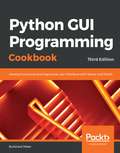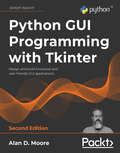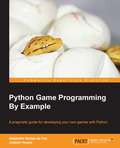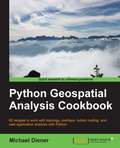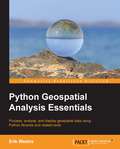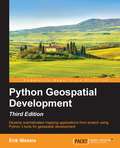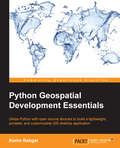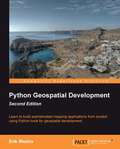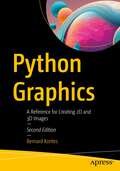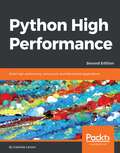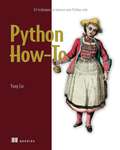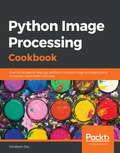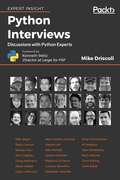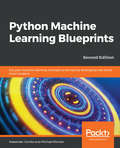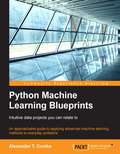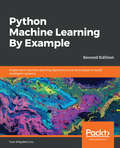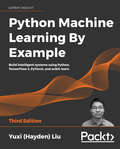- Table View
- List View
Python GUI Programming Cookbook: Develop functional and responsive user interfaces with tkinter and PyQt5, 3rd Edition
by Burkhard MeierOver 90 recipes to help you develop widgets, forms, layouts, charts, and much more using the latest features of Python 3 Key Features Use object-oriented programming to develop impressive GUIs in Python Create interesting charts to visually represent data using Matplotlib Develop GUIs with the latest versions of tkinter, PyQt5, and wxPython frameworks Book Description Python is a multi-domain, interpreted programming language that is easy to learn and implement. With its wide support for frameworks to develop GUIs, you can build interactive and beautiful GUI-based applications easily using Python. This third edition of Python GUI Programming Cookbook follows a task-based approach to help you create effective GUIs with the smallest amount of code. Every recipe in this book builds upon the last to create an entire, real-life GUI application. These recipes also help you solve problems that you might encounter while developing GUIs. This book mainly focuses on using Python's built-in tkinter GUI framework. You'll learn how to create GUIs in Python using simple programming styles and object-oriented programming (OOP). As you add more widgets and expand your GUI, you will learn how to connect to networks, databases, and graphical libraries that greatly enhance the functionality of your GUI. You'll also learn how to use threading to ensure that your GUI doesn't become unresponsive. Toward the end, you'll learn about the versatile PyQt GUI framework, which comes along with its own visual editor that allows you to design GUIs using drag and drop features. By the end of the book, you'll be an expert in designing Python GUIs and be able to develop a variety of GUI applications with ease. What you will learn Create amazing GUIs with Python's built-in tkinter module Customize GUIs using layout managers to arrange GUI widgets Advance from the typical waterfall coding style to an OOP style using Python Develop beautiful charts using the free Matplotlib Python module Use threading in a networked environment to make GUIs responsive Discover ways to connect GUIs to a MySQL database Understand how unit tests can be created and internationalize GUI Delve into the world of GUI creation using PyQt5 Who this book is for If you're a programmer or developer looking to enhance your Python skills by writing powerful GUI applications, this book is for you. Familiarity with the Python programming language is necessary to get the most out of the book.
Python GUI Programming with Tkinter: Design and build functional and user-friendly GUI applications, 2nd Edition
by Alan D. MooreTransform your evolving user requirements into feature-rich Tkinter applicationsKey FeaturesExtensively revised with new content on RESTful networking, classes in Tkinter, and the Notebook widgetTake advantage of Tkinter's lightweight, portable, and easy-to-use featuresBuild better-organized code and learn to manage an evolving codebaseBook DescriptionTkinter is widely used to build GUIs in Python due to its simplicity. In this book, you'll discover Tkinter's strengths and overcome its challenges as you learn to develop fully featured GUI applications.Python GUI Programming with Tkinter, Second Edition, will not only provide you with a working knowledge of the Tkinter GUI library, but also a valuable set of skills that will enable you to plan, implement, and maintain larger applications. You'll build a full-blown data entry application from scratch, learning how to grow and improve your code in response to continually changing user and business needs.You'll develop a practical understanding of tools and techniques used to manage this evolving codebase and go beyond the default Tkinter widget capabilities. You'll implement version control and unit testing, separation of concerns through the MVC design pattern, and object-oriented programming to organize your code more cleanly.You'll also gain experience with technologies often used in workplace applications, such as SQL databases, network services, and data visualization libraries. Finally, you'll package your application for wider distribution and tackle the challenge of maintaining cross-platform compatibility.What you will learnProduce well-organized, functional, and responsive GUI applicationsExtend the functionality of existing widgets using classes and OOPPlan wisely for the expansion of your app using MVC and version controlMake sure your app works as intended through widget validation and unit testingUse tools and processes to analyze and respond to user requestsBecome familiar with technologies used in workplace applications, including SQL, HTTP, Matplotlib, threading, and CSVUse PostgreSQL authentication to ensure data security for your applicationWho this book is forThis book is for programmers who understand the syntax of Python, but do not yet have the skills, techniques, and knowledge to design and implement a complete software application. A fair grasp of basic Python syntax is required.
Python GUI Programming with Tkinter: Develop responsive and powerful GUI applications with Tkinter
by Alan D MooreFind out how to create visually stunning and feature-rich applications by empowering Python's built-in Tkinter GUI toolkitKey Features Explore Tkinter's powerful features to easily design and customize your GUI application Learn the basics of 2D and 3D animation in GUI applications. Learn to integrate stunning Data Visualizations using Tkinter Canvas and Matplotlib.Book DescriptionTkinter is a lightweight, portable, and easy-to-use graphical toolkit available in the Python Standard Library, widely used to build Python GUIs due to its simplicity and availability. This book teaches you to design and build graphical user interfaces that are functional, appealing, and user-friendly using the powerful combination of Python and Tkinter.After being introduced to Tkinter, you will be guided step-by-step through the application development process. Over the course of the book, your application will evolve from a simple data-entry form to a complex data management and visualization tool while maintaining a clean and robust design. In addition to building the GUI, you'll learn how to connect to external databases and network resources, test your code to avoid errors, and maximize performance using asynchronous programming. You'll make the most of Tkinter's cross-platform availability by learning how to maintain compatibility, mimic platform-native look and feel, and build executables for deployment across popular computing platforms.By the end of this book, you will have the skills and confidence to design and build powerful high-end GUI applications to solve real-world problems.What you will learn Implement the tools provided by Tkinter to design beautiful GUIs Discover cross-platform development through minor customizations in your existing application Visualize graphs in real time as data comes in using Tkinter's animation capabilities Use PostgreSQL authentication to ensure data security for your application Write unit tests to avoid regressions when updating codeWho this book is forThis book will appeal to developers and programmers who would like to build GUI-based applications. Knowledge of Python is a prerequisite.
Python Game Programming By Example
by Joseph Howse Alejandro Rodas PazA pragmatic guide for developing your own games with Python About This Book * Strengthen your fundamentals of game programming with Python language * Seven hands-on games to create 2D and 3D games rapidly from scratch * Illustrative guide to explore the different GUI libraries for building your games Who This Book Is For If you have ever wanted to create casual games in Python and you would like to explore various GUI technologies that this language offers, this is the book for you. This title is intended for beginners to Python with little or no knowledge of game development, and it covers step by step how to build seven different games, from the well-known Space Invaders to a classical 3D platformer. What You Will Learn * Take advantage of Python's clean syntax to build games quickly * Discover distinct frameworks for developing graphical applications * Implement non-player characters (NPCs) with autonomous and seemingly intelligent behaviors * Design and code some popular games like Pong and tower defense * Compose maps and levels for your sprite-based games in an easy manner * Modularize and apply object-oriented principles during the design of your games * Exploit libraries like Chimpunk2D, cocos2d, and Tkinter * Create natural user interfaces (NUIs), using a camera and computer vision algorithms to interpret the player's real-world actions In Detail With a growing interest in learning to program, game development is an appealing topic for getting started with coding. From geometry to basic Artificial Intelligence algorithms, there are plenty of concepts that can be applied in almost every game. Python is a widely used general-purpose, high-level programming language. It provides constructs intended to enable clear programs on both a small and large scale. It is the third most popular language whose grammatical syntax is not predominantly based on C. Python is also very easy to code and is also highly flexible, which is exactly what is required for game development. The user-friendliness of this language allows beginners to code games without too much effort or training. Python also works with very little code and in most cases uses the "use cases" approach, reserving lengthy explicit coding for outliers and exceptions, making game development an achievable feat. Python Game Programming by Example enables readers to develop cool and popular games in Python without having in-depth programming knowledge of Python. The book includes seven hands-on projects developed with several well-known Python packages, as well as a comprehensive explanation about the theory and design of each game. It will teach readers about the techniques of game design and coding of some popular games like Pong and tower defense. Thereafter, it will allow readers to add levels of complexities to make the games more fun and realistic using 3D. At the end of the book, you will have added several GUI libraries like Chimpunk2D, cocos2d, and Tkinter in your tool belt, as well as a handful of recipes and algorithms for developing games with Python. Style and approach This book is an example-based guide that will teach you to build games using Python. This book follows a step-by-step approach as it is aimed at beginners who would like to get started with basic game development. By the end of this book you will be competent game developers with good knowledge of programming in Python.
Python Geospatial Analysis Cookbook
by Michael DienerOver 60 recipes to work with topology, overlays, indoor routing, and web application analysis with Python About This Book * Explore the practical process of using geospatial analysis to solve simple to complex problems with reusable recipes * Concise step-by-step instructions to teach you about projections, vector, raster, overlay, indoor routing and topology analysis * Create a basic indoor routing application with geodjango Who This Book Is For If you are a student, teacher, programmer, geospatial or IT administrator, GIS analyst, researcher, or scientist looking to do spatial analysis, then this book is for you. Anyone trying to answer simple to complex spatial analysis questions will get a working demonstration of the power of Python with real-world data. Some of you may be beginners with GIS, but most of you will probably have a basic understanding of geospatial analysis and programming. What You Will Learn * Discover the projection and coordinate system information of your data and learn how to transform that data into different projections * Import or export your data into different data formats to prepare it for your application or spatial analysis * Use the power of PostGIS with Python to take advantage of the powerful analysis functions * Execute spatial analysis functions on vector data including clipping, spatial joins, measuring distances, areas, and combining data to new results * Create your own set of topology rules to perform and ensure quality assurance rules in Python * Find the shortest indoor path with network analysis functions in easy, extensible recipes revolving around all kinds of network analysis problems * Visualize your data on a map using the visualization tools and methods available to create visually stunning results * Build an indoor routing web application with GeoDjango to include your spatial analysis tools built from the previous recipes In Detail Geospatial development links your data to places on the Earth's surface. Its analysis is used in almost every industry to answer location type questions. Combined with the power of the Python programming language, which is becoming the de facto spatial scripting choice for developers and analysts worldwide, this technology will help you to solve real-world spatial problems. This book begins by tackling the installation of the necessary software dependencies and libraries needed to perform spatial analysis with Python. From there, the next logical step is to prepare our data for analysis; we will do this by building up our tool box to deal with data preparation, transformations, and projections. Now that our data is ready for analysis, we will tackle the most common analysis methods for vector and raster data. To check or validate our results, we will explore how to use topology checks to ensure top-quality results. This is followed with network routing analysis focused on constructing indoor routes within buildings, over different levels. Finally, we put several recipes together in a GeoDjango web application that demonstrates a working indoor routing spatial analysis application. The round trip will provide you all the pieces you need to accomplish your own spatial analysis application to suit your requirements. Style and approach Easy-to-follow, step-by-step recipes, explaining from start to finish how to accomplish real-world tasks.
Python Geospatial Analysis Essentials
by Erik WestraIf you are an experienced Python developer and wish to get up-to-speed with geospatial programming, then this book is for you. While familiarity with installing third-party Python libraries would be an advantage, no prior knowledge of geospatial programming is required.
Python Geospatial Development
by Erik WestraThis is a tutorial style book that will teach usage of Python tools for GIS using simple practical examples and then show you how to build a complete mapping application from scratch. The book assumes basic knowledge of Python. No knowledge of Open Source GIS is required. This book is useful for Python developers who want to get up to speed with Open Source GIS in order to build GIS applications or integrate Geo-Spatial features into their applications.
Python Geospatial Development - Third Edition
by Erik WestraDevelop sophisticated mapping applications from scratch using Python 3 tools for geospatial development About This Book * Build web applications based around maps and geospatial data using Python 3.x * Install and use various toolkits and obtain geospatial data for use in your programs * This practical, hands-on book will teach you all about geospatial development in Python Who This Book Is For This book is for experienced Python developers who want to learn about geospatial concepts, obtain and work with geospatial data, solve spatial problems, and build sophisticated map-based applications using Python. What You Will Learn * Access, manipulate, and display geospatial data from within your Python programs * Master the core geospatial concepts of location, distance, units, projections, and datums * Read and write geospatial data in both vector and raster format * Perform complex, real-world geospatial calculations using Python * Store and access geospatial information in a database * Use points, lines, and polygons within your Python programs * Convert geospatial data into attractive maps using Python-based tools * Build complete web-based mapping applications using Python In Detail Geospatial development links your data to locations on the surface of the Earth. Writing geospatial programs involves tasks such as grouping data by location, storing and analyzing large amounts of spatial information, performing complex geospatial calculations, and drawing colorful interactive maps. In order to do this well, you'll need appropriate tools and techniques, as well as a thorough understanding of geospatial concepts such as map projections, datums, and coordinate systems. This book provides an overview of the major geospatial concepts, data sources, and toolkits. It starts by showing you how to store and access spatial data using Python, how to perform a range of spatial calculations, and how to store spatial data in a database. Further on, the book teaches you how to build your own slippy map interface within a web application, and finishes with the detailed construction of a geospatial data editor using the GeoDjango framework. By the end of this book, you will be able to confidently use Python to write your own geospatial applications ranging from quick, one-off utilities to sophisticated web-based applications using maps and other geospatial data. Style and approach This book is a comprehensive course in geospatial development. The concepts you need to know are presented in a hands-on fashion with example code to help you to solve real-world problems right away. Larger programs are built up step by step while guiding you through the process of building your own sophisticated mapping applications.
Python Geospatial Development Essentials
by Karim BahgatThis book provides you with the resources to successfully develop your own GIS application in Python. The book begins by walking you through the loading and saving of data structures before you start to build the look and feel of your application and create its interactive map window. You'll then move on to managing, editing, and analyzing spatial data from within the application and finish with instructions for packaging the application for distribution. By the end of the book, you should be able to use your GIS application as a template for further development, with the potential to expand and customize it to suit your needs.
Python Geospatial Development, Second Edition
by Erik WestraThis is a tutorial style book that will teach usage of Python tools for GIS using simple practical examples and then show you how to build a complete mapping application from scratch. The book assumes basic knowledge of Python. No knowledge of Open Source GIS is required.Experienced Python developers who want to learn about geospatial concepts, work with geospatial data, solve spatial problems, and build map-based applications.This book will be useful those who want to get up to speed with Open Source GIS in order to build GIS applications or integrate Geo-Spatial features into their existing applications.
Python Graphics: A Reference for Creating 2D and 3D Images
by B. J. KoritesUse Python's built-in features to create innovative graphics for data visualization and technical illustrations. This book goes beyond simple commands and libraries to explain how to not only display but also rotate, shade, and edit graphics for any purpose. Starting with the essential Python functions to set up a plotting space and produce 2 and 3-dimensional objects, you'll learn how to construct more complex objects, translate and rotate them, remove hidden lines, introduce shading to add realism, and project images to visualize any dataset. The final chapter includes several worked applications in science and engineering including planetary models, which you can adapt for your own use.Written for developers who want to harness Python's capabilities to fine-tune their images, Python Graphics covers the different commands for plotting dots, lines, arrows, or arcs, creating custom plotting grids, correcting distortions, adding text and labels to illustrations, manipulating arcs and circles, specify and use colors, and more. Armed with these techniques and core math skills, you'll be ready to create and customize detailed technical illustrations or data visualizations. What You'll LearnUse Python′s built-in commands for plotting, removing distortions, and rotating objectsCreate and edit 2D and 3D objectsDevelop illustrations for scientific and engineering applicationsWho This Book Is ForPython developers looking for tips on how to create illustrations and visualizations, as well as scientists, engineers, or students using Python. It assumes familiarity with vectors, matrices, geometry and trigonometry.
Python Graphics: A Reference for Creating 2D and 3D Images
by Bernard KoritesThis book shows how to use Python’s built-in graphics primitives - points, lines, and arrows – to create complex graphics for the visualization of two- and three-dimensional objects, data sets, and technical illustrations. This updated edition provides more detailed explanations where required, especially regarding Python code, and explores scientific applications to topics of contemporary importance. You’ll learn how to create any 2D or 3D object or illustration, as well as how to display images, use color, translate, rotate, shade, add shadows that are cast on other objects, remove hidden lines, plot 2D and 3D data, fit lines and curves to data sets, display points of intersection between 2D and 3D objects, and create digital art. Demonstrations are included which illustrate graphics programming techniques by example, the best way to learn a language. Also brand new to this edition are demonstrations on how to visualize electron probability clouds around a nucleus, climate change, ecological diversity, population dynamics, and resource management. Python source code, including detailed explanations, is included for all applications, making the book more accessible to novice Python programmers. After completing this book, you will be able to create compelling graphic images without being limited to functions available in existing Python libraries. What You Will Learn Create 2D and 3D graphic imagesAdd text and symbols to imagesShade 3D objectsDisplay cast shadowsUse color for maximum effectView 2D and 3D data setsFit lines and curves to data sets Who This Book Is For Python developers, scientists, engineers, and students who use Python to produce technical illustrations and display and analyze data sets. Assumes familiarity with vectors, matrices, geometry and trigonometry.
Python High Performance - Second Edition
by Gabriele LanaroLearn how to use Python to create efficient applications About This Book • Identify the bottlenecks in your applications and solve them using the best profiling techniques • Write efficient numerical code in NumPy, Cython, and Pandas • Adapt your programs to run on multiple processors and machines with parallel programming Who This Book Is For The book is aimed at Python developers who want to improve the performance of their application. Basic knowledge of Python is expected What You Will Learn • Write efficient numerical code with the NumPy and Pandas libraries • Use Cython and Numba to achieve native performance • Find bottlenecks in your Python code using profilers • Write asynchronous code using Asyncio and RxPy • Use Tensorflow and Theano for automatic parallelism in Python • Set up and run distributed algorithms on a cluster using Dask and PySpark In Detail Python is a versatile language that has found applications in many industries. The clean syntax, rich standard library, and vast selection of third-party libraries make Python a wildly popular language. Python High Performance is a practical guide that shows how to leverage the power of both native and third-party Python libraries to build robust applications. The book explains how to use various profilers to find performance bottlenecks and apply the correct algorithm to fix them. The reader will learn how to effectively use NumPy and Cython to speed up numerical code. The book explains concepts of concurrent programming and how to implement robust and responsive applications using Reactive programming. Readers will learn how to write code for parallel architectures using Tensorflow and Theano, and use a cluster of computers for large-scale computations using technologies such as Dask and PySpark. By the end of the book, readers will have learned to achieve performance and scale from their Python applications. Style and approach A step-by-step practical guide filled with real-world use cases and examples
Python High Performance Programming
by Gabriele LanaroAn exciting, easy-to-follow guide illustrating the techniques to boost the performance of Python code, and their applications with plenty of hands-on examples.If you are a programmer who likes the power and simplicity of Python and would like to use this language for performance-critical applications, this book is ideal for you. All that is required is a basic knowledge of the Python programming language. The book will cover basic and advanced topics so will be great for you whether you are a new or a seasoned Python developer.
Python How-To: 63 techniques to improve your Python code
by Yong CuiHave you ever asked yourself, &“How do I do that in Python?&” If so, you&’ll love this practical collection of the most important Python techniques.Python How-To includes over 60 detailed answers to questions like: How do I join and split strings? How do I access dictionary keys, values, and items? How do I set and use the return value in function calls? How do I process JSON data? How do I create lazy attributes to improve performance? How do I change variables in a different namespace? …and much more Python How-To walks you through the most important coding techniques in Python. Whether you&’re doing data science, building web applications, or writing admin scripts, you&’ll find answers to your &“how-to&” questions in this book. Inside you&’ll find important insights into both Python basics and deep-dive topics to help you skill-up at any stage of your Python career. Author Yong Cui&’s clear and practical writing is instantly accessible and makes it easy to take advantage of Python&’s versatile tools and libraries. Perfect to be read both from cover to cover, and whenever you need help troubleshooting your code. About the Technology Python How-To uses a simple but powerful method to lock in 63 core Python skills. You&’ll start with a question, like &“How do I find items in a sequence?&” Next, you&’ll see an example showing the basic solution in crystal-clear code. You&’ll then explore interesting variations, such as finding substrings or identifying custom classes. Finally, you&’ll practice with a challenge exercise before moving on to the next How-To. About the Book This practical guide covers all the language features you&’ll need to get up and running with Python. As you go, you&’ll explore best practices for writing great Python code. Practical suggestions and engaging graphics make each important technique come to life. Author Yong Cui&’s careful cross-referencing reveals how you can reuse features and concepts in different contexts. What&’s Inside How to: Join and split strings Access dictionary keys, values, and items Set and use the return value in function calls Process JSON data Create lazy attributes to improve performance Change variables in a different namespace …and much more. About the Reader For beginning to intermediate Python programmers. About the Author Dr. Yong Cui has been working with Python in bioscience for data analysis, machine learning, and tool development for over 15 years. Table of Contents 1 Developing a pragmatic learning strategy PART 1 - USING BUILT-IN DATA MODELS 2 Processing and formatting strings 3 Using built-in data containers 4 Dealing with sequence data 5 Iterables and iterations PART 2 - DEFINING FUNCTIONS 6 Defining user-friendly functions 7 Using functions beyond the basics PART 3 - DEFINING CLASSES 8 Defining user-friendly classes 9 Using classes beyond the basics PART 4 - MANIPULATING OBJECTS AND FILES 10 Fundamentals of objects 11 Dealing with files PART 5 - SAFEGUARDING THE CODEBASE 12 Logging and exception handling 13 Debugging and testing PART 6 - BUILDING A WEB APP 14 Completing a real project
Python Image Processing Cookbook: Over 60 recipes to help you perform complex image processing and computer vision tasks with ease
by Sandipan DeyExplore Keras, scikit-image, open source computer vision (OpenCV), Matplotlib, and a wide range of other Python tools and frameworks to solve real-world image processing problems Key Features Discover solutions to complex image processing tasks using Python tools such as scikit-image and Keras Learn popular concepts such as machine learning, deep learning, and neural networks for image processing Explore common and not-so-common challenges faced in image processing Book Description With the advancements in wireless devices and mobile technology, there's increasing demand for people with digital image processing skills in order to extract useful information from the ever-growing volume of images. This book provides comprehensive coverage of the relevant tools and algorithms, and guides you through analysis and visualization for image processing. With the help of over 60 cutting-edge recipes, you'll address common challenges in image processing and learn how to perform complex tasks such as object detection, image segmentation, and image reconstruction using large hybrid datasets. Dedicated sections will also take you through implementing various image enhancement and image restoration techniques, such as cartooning, gradient blending, and sparse dictionary learning. As you advance, you'll get to grips with face morphing and image segmentation techniques. With an emphasis on practical solutions, this book will help you apply deep learning techniques such as transfer learning and fine-tuning to solve real-world problems. By the end of this book, you'll be proficient in utilizing the capabilities of the Python ecosystem to implement various image processing techniques effectively. What you will learn Implement supervised and unsupervised machine learning algorithms for image processing Use deep neural network models for advanced image processing tasks Perform image classification, object detection, and face recognition Apply image segmentation and registration techniques on medical images to assist doctors Use classical image processing and deep learning methods for image restoration Implement text detection in images using Tesseract, the optical character recognition (OCR) engine Understand image enhancement techniques such as gradient blending Who this book is for This book is for image processing engineers, computer vision engineers, software developers, machine learning engineers, or anyone who wants to become well-versed with image processing techniques and methods using a recipe-based approach. Although no image processing knowledge is expected, prior Python coding experience is necessary to understand key concepts covered in the book.
Python Interviews: Discussions with Python Experts
by Michael DriscollMike Driscoll takes you on a journey talking to a hall-of-fame list of truly remarkable Python experts. You’ll be inspired every time by their passion for the Python language, as they share with you their experiences, contributions, and careers in Python. Key Features Hear from these key Python thinkers about the current status of Python, and where it's heading in the future Listen to their close thoughts on significant Python topics, such as Python's role in scientific computing, and machine learning Understand the direction of Python, and what needs to change for Python 4 Book Description Each of these twenty Python Interviews can inspire and refresh your relationship with Python and the people who make Python what it is today. Let these interviews spark your own creativity, and discover how you also have the ability to make your mark on a thriving tech community. This book invites you to immerse in the Python landscape, and let these remarkable programmers show you how you too can connect and share with Python programmers around the world. Learn from their opinions, enjoy their stories, and use their tech tips. Brett Cannon - former director of the PSF, Python core developer, led the migration to Python 3. Steve Holden - tireless Python promoter and former chairman and director of the PSF. Carol Willing - former director of the PSF and Python core developer, Project Jupyter Steering Council member. Nick Coghlan - founding member of the PSF and Python core developer. Jessica McKellar - former director of the PSF and Python activist. Marc-André Lemburg - Python core developer and founding member of the PSF. Glyph Lefkowitz - founder of Twisted and fellow of the PSF Doug Hellmann - fellow of the PSF, creator of the Python Module of the Week blog, Python community member since 1998. Massimo Di Pierro - fellow of the PSF, data scientist and the inventor of web2py. Alex Martelli - fellow of the PSF and co-author of Python in a Nutshell. Barry Warsaw - fellow of the PSF, Python core developer since 1995, and original member of PythonLabs. Tarek Ziadé - founder of Afpy and author of Expert Python Programming. Sebastian Raschka - data scientist and author of Python Machine Learning. Wesley Chun - fellow of the PSF and author of the Core Python Programming books. Steven Lott - Python blogger and author of Python for Secret Agents. Oliver Schoenborn - author of Pypubsub and wxPython mailing list contributor. Al Sweigart - bestselling author and creator of the Python modules Pyperclip and PyAutoGUI. Luciano Ramalho - fellow of the PSF and the author of Fluent Python. Mike Bayer - fellow of the PSF, creator of open source libraries including SQLAlchemy. Jake Vanderplas - data scientist and author of Python Data Science Handbook. What you will learn How successful programmers think The history of Python Insights into the minds of the Python core team Trends in Python programmingWho this book is for Python programmers and students interested in the way that Python is used – past and present – with useful anecdotes. It will also be of interest to those looking to gain insights from top programmers.
Python Machine Learning
by Sebastian RaschkaUnlock deeper insights into Machine Leaning with this vital guide to cutting-edge predictive analytics About This Book * Leverage Python's most powerful open-source libraries for deep learning, data wrangling, and data visualization * Learn effective strategies and best practices to improve and optimize machine learning systems and algorithms * Ask - and answer - tough questions of your data with robust statistical models, built for a range of datasets Who This Book Is For If you want to find out how to use Python to start answering critical questions of your data, pick up Python Machine Learning - whether you want to get started from scratch or want to extend your data science knowledge, this is an essential and unmissable resource. What You Will Learn * Explore how to use different machine learning models to ask different questions of your data * Learn how to build neural networks using Pylearn 2 and Theano * Find out how to write clean and elegant Python code that will optimize the strength of your algorithms * Discover how to embed your machine learning model in a web application for increased accessibility * Predict continuous target outcomes using regression analysis * Uncover hidden patterns and structures in data with clustering * Organize data using effective pre-processing techniques * Get to grips with sentiment analysis to delve deeper into textual and social media data In Detail Machine learning and predictive analytics are transforming the way businesses and other organizations operate. Being able to understand trends and patterns in complex data is critical to success, becoming one of the key strategies for unlocking growth in a challenging contemporary marketplace. Python can help you deliver key insights into your data - its unique capabilities as a language let you build sophisticated algorithms and statistical models that can reveal new perspectives and answer key questions that are vital for success. Python Machine Learning gives you access to the world of predictive analytics and demonstrates why Python is one of the world's leading data science languages. If you want to ask better questions of data, or need to improve and extend the capabilities of your machine learning systems, this practical data science book is invaluable. Covering a wide range of powerful Python libraries, including scikit-learn, Theano, and Pylearn2, and featuring guidance and tips on everything from sentiment analysis to neural networks, you'll soon be able to answer some of the most important questions facing you and your organization. Style and approach Python Machine Learning connects the fundamental theoretical principles behind machine learning to their practical application in a way that focuses you on asking and answering the right questions. It walks you through the key elements of Python and its powerful machine learning libraries, while demonstrating how to get to grips with a range of statistical models.
Python Machine Learning
by Wei-Meng LeePython makes machine learning easy for beginners and experienced developers With computing power increasing exponentially and costs decreasing at the same time, there is no better time to learn machine learning using Python. Machine learning tasks that once required enormous processing power are now possible on desktop machines. However, machine learning is not for the faint of heart—it requires a good foundation in statistics, as well as programming knowledge. Python Machine Learning will help coders of all levels master one of the most in-demand programming skillsets in use today. Readers will get started by following fundamental topics such as an introduction to Machine Learning and Data Science. For each learning algorithm, readers will use a real-life scenario to show how Python is used to solve the problem at hand. • Python data science—manipulating data and data visualization • Data cleansing • Understanding Machine learning algorithms • Supervised learning algorithms • Unsupervised learning algorithms • Deploying machine learning models Python Machine Learning is essential reading for students, developers, or anyone with a keen interest in taking their coding skills to the next level.
Python Machine Learning - Second Edition
by Sebastian Raschka Vahid MirjaliliUnlock modern machine learning and deep learning techniques with Python by using the latest cutting-edge open source Python libraries. About This Book • Second edition of the bestselling book on Machine Learning • A practical approach to key frameworks in data science, machine learning, and deep learning • Use the most powerful Python libraries to implement machine learning and deep learning • Get to know the best practices to improve and optimize your machine learning systems and algorithms Who This Book Is For If you know some Python and you want to use machine learning and deep learning, pick up this book. Whether you want to start from scratch or extend your machine learning knowledge, this is an essential and unmissable resource. Written for developers and data scientists who want to create practical machine learning and deep learning code, this book is ideal for developers and data scientists who want to teach computers how to learn from data. What You Will Learn • Understand the key frameworks in data science, machine learning, and deep learning • Harness the power of the latest Python open source libraries in machine learning • Explore machine learning techniques using challenging real-world data • Master deep neural network implementation using the TensorFlow library • Learn the mechanics of classification algorithms to implement the best tool for the job • Predict continuous target outcomes using regression analysis • Uncover hidden patterns and structures in data with clustering • Delve deeper into textual and social media data using sentiment analysis In Detail Machine learning is eating the software world, and now deep learning is extending machine learning. Understand and work at the cutting edge of machine learning, neural networks, and deep learning with this second edition of Sebastian Raschka's bestselling book, Python Machine Learning. Thoroughly updated using the latest Python open source libraries, this book offers the practical knowledge and techniques you need to create and contribute to machine learning, deep learning, and modern data analysis. Fully extended and modernized, Python Machine Learning Second Edition now includes the popular TensorFlow deep learning library. The scikit-learn code has also been fully updated to include recent improvements and additions to this versatile machine learning library. Sebastian Raschka and Vahid Mirjalili's unique insight and expertise introduce you to machine learning and deep learning algorithms from scratch, and show you how to apply them to practical industry challenges using realistic and interesting examples. By the end of the book, you'll be ready to meet the new data analysis opportunities in today's world. If you've read the first edition of this book, you'll be delighted to find a new balance of classical ideas and modern insights into machine learning. Every chapter has been critically updated, and there are new chapters on key technologies. You'll be able to learn and work with TensorFlow more deeply than ever before, and get essential coverage of the Keras neural network library, along with the most recent updates to scikit-learn. Style and Approach Python Machine Learning Second Edition takes a practical, hands-on coding approach so you can learn about machine learning by coding with Python. This book moves fluently between the theoretical principles of machine learning and the practical details of implementation with Python.
Python Machine Learning Blueprints - Second Edition: Put your machine learning concepts to the test by developing real-world smart projects, 2nd Edition
by Alexander CombsThis book is for machine learning practitioners, data scientists, and deep learning enthusiasts who want to take their machine learning skills to the next level by building real-world projects. Implement libraries from Python ecosystem to build a range of projects addressing various machine learning domains. Knowledge of Python programming language and machine learning concepts are recommended.
Python Machine Learning Blueprints: Intuitive data projects you can relate to
by Alexander T. CombsAn approachable guide to applying advanced machine learning methods to everyday problems About This Book * Put machine learning principles into practice to solve real-world problems * Get to grips with Python's impressive range of Machine Learning libraries and frameworks * From retrieving data from APIs to cleaning and visualization, become more confident at tackling every stage of the data pipeline Who This Book Is For Python programmers and data scientists - put your skills to the test with this practical guide dedicated to real-world machine learning that makes a real impact. What You Will Learn * Explore and use Python's impressive machine learning ecosystem * Successfully evaluate and apply the most effective models to problems * Learn the fundamentals of NLP - and put them into practice * Visualize data for maximum impact and clarity * Deploy machine learning models using third party APIs * Get to grips with feature engineering In Detail Machine Learning is transforming the way we understand and interact with the world around us. But how much do you really understand it? How confident are you interacting with the tools and models that drive it? Python Machine Learning Blueprints puts your skills and knowledge to the test, guiding you through the development of some awesome machine learning applications and algorithms with real-world examples that demonstrate how to put concepts into practice. You'll learn how to use cluster techniques to discover bargain air fares, and apply linear regression to find yourself a cheap apartment - and much more. Everything you learn is backed by a real-world example, whether its data manipulation or statistical modelling. That way you're never left floundering in theory - you'll be simply collecting and analyzing data in a way that makes a real impact. Style and approach Packed with real-world projects, this book takes you beyond the theory to demonstrate how to apply machine learning techniques to real problems.
Python Machine Learning By Example - Second Edition: Implement machine learning algorithms and techniques to build intelligent systems, 2nd Edition
by Yuxi (Hayden) LiuThis book is for Machine Learning Aspirants, Data Analysts, Data Engineers who are highly passionate about Machine Learning and wants to start getting employed in Machine Learning assignments. Prior knowledge of python coding is assumed and basic familiarity with the statistical concept is beneficial although not a mandate
Python Machine Learning By Example: Build intelligent systems using Python, TensorFlow 2, PyTorch, and scikit-learn, 3rd Edition
by Yuxi (Hayden) LiuA comprehensive guide to get you up to speed with the latest developments of practical machine learning with Python and upgrade your understanding of machine learning (ML) algorithms and techniquesKey FeaturesDive into machine learning algorithms to solve the complex challenges faced by data scientists todayExplore cutting edge content reflecting deep learning and reinforcement learning developmentsUse updated Python libraries such as TensorFlow, PyTorch, and scikit-learn to track machine learning projects end-to-endBook DescriptionPython Machine Learning By Example, Third Edition serves as a comprehensive gateway into the world of machine learning (ML).With six new chapters, on topics including movie recommendation engine development with Naive Bayes, recognizing faces with support vector machine, predicting stock prices with artificial neural networks, categorizing images of clothing with convolutional neural networks, predicting with sequences using recurring neural networks, and leveraging reinforcement learning for making decisions, the book has been considerably updated for the latest enterprise requirements.At the same time, this book provides actionable insights on the key fundamentals of ML with Python programming. Hayden applies his expertise to demonstrate implementations of algorithms in Python, both from scratch and with libraries.Each chapter walks through an industry-adopted application. With the help of realistic examples, you will gain an understanding of the mechanics of ML techniques in areas such as exploratory data analysis, feature engineering, classification, regression, clustering, and NLP.By the end of this ML Python book, you will have gained a broad picture of the ML ecosystem and will be well-versed in the best practices of applying ML techniques to solve problems.What you will learnUnderstand the important concepts in ML and data scienceUse Python to explore the world of data mining and analyticsScale up model training using varied data complexities with Apache SparkDelve deep into text analysis and NLP using Python libraries such NLTK and GensimSelect and build an ML model and evaluate and optimize its performanceImplement ML algorithms from scratch in Python, TensorFlow 2, PyTorch, and scikit-learnWho this book is forIf you're a machine learning enthusiast, data analyst, or data engineer highly passionate about machine learning and want to begin working on machine learning assignments, this book is for you.Prior knowledge of Python coding is assumed and basic familiarity with statistical concepts will be beneficial, although this is not necessary.
Python Machine Learning By Example: Implement Machine Learning Algorithms And Techniques To Build Intelligent Systems, 2nd Edition
by Yuxi Hayden LiuTake tiny steps to enter the big world of data science through this interesting guide About This Book • Learn the fundamentals of machine learning and build your own intelligent applications • Master the art of building your own machine learning systems with this example-based practical guide • Work with important classification and regression algorithms and other machine learning techniques Who This Book Is For This book is for anyone interested in entering the data science stream with machine learning. Basic familiarity with Python is assumed. What You Will Learn • Exploit the power of Python to handle data extraction, manipulation, and exploration techniques • Use Python to visualize data spread across multiple dimensions and extract useful features • Dive deep into the world of analytics to predict situations correctly • Implement machine learning classification and regression algorithms from scratch in Python • Be amazed to see the algorithms in action • Evaluate the performance of a machine learning model and optimize it • Solve interesting real-world problems using machine learning and Python as the journey unfolds In Detail Data science and machine learning are some of the top buzzwords in the technical world today. A resurging interest in machine learning is due to the same factors that have made data mining and Bayesian analysis more popular than ever. This book is your entry point to machine learning. This book starts with an introduction to machine learning and the Python language and shows you how to complete the setup. Moving ahead, you will learn all the important concepts such as, exploratory data analysis, data preprocessing, feature extraction, data visualization and clustering, classification, regression and model performance evaluation. With the help of various projects included, you will find it intriguing to acquire the mechanics of several important machine learning algorithms – they are no more obscure as they thought. Also, you will be guided step by step to build your own models from scratch. Toward the end, you will gather a broad picture of the machine learning ecosystem and best practices of applying machine learning techniques. Through this book, you will learn to tackle data-driven problems and implement your solutions with the powerful yet simple language, Python. Interesting and easy-to-follow examples, to name some, news topic classification, spam email detection, online ad click-through prediction, stock prices forecast, will keep you glued till you reach your goal. Style and approach This book is an enticing journey that starts from the very basics and gradually picks up pace as the story unfolds. Each concept is first succinctly defined in the larger context of things, followed by a detailed explanation of their application. Every concept is explained with the help of a project that solves a real-world problem, and involves hands-on work—giving you a deep insight into the world of machine learning. With simple yet rich language—Python—you will understand and be able to implement the examples with ease.
